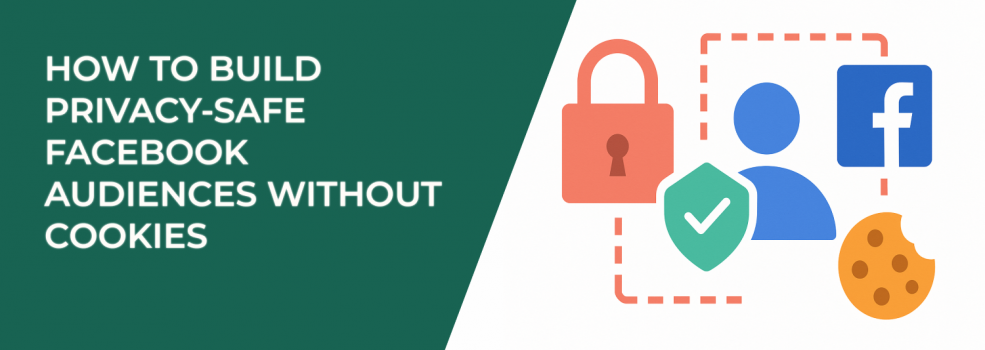The digital ad world is changing fast. Cookies — the small pieces of code that used to track people online — are disappearing. For years, cookies helped advertisers retarget visitors, measure results, and build Facebook audiences. But now, with new privacy laws and browser restrictions, relying on cookies is no longer a safe bet.
Does that mean you can’t run effective Facebook campaigns anymore? Not at all. You just need new ways to build audiences that respect user privacy while keeping performance strong. Let’s break down exactly how.
Why Cookies Are on Their Way Out
Cookies worked like digital breadcrumbs. They followed people from site to site, collected behavior data, and sent it back to advertisers.
But things started to change. Governments introduced privacy laws like GDPR in Europe and CCPA in California. Browsers like Safari and Firefox blocked third-party cookies by default. Even Google Chrome — the biggest browser — is phasing them out.
The message is clear: people want more privacy online. As advertisers, we need to respect that and find smarter, more transparent ways to reach our audiences.
If you’ve already noticed campaign delivery issues like “ad set may get zero,” you’ve seen the impact of these shifts firsthand. Here’s a breakdown of why you see that warning and how to fix it.
First-Party Data: Your New Secret Weapon
If third-party cookies are fading, first-party data becomes the star. First-party data is the information your customers share directly with you. It could be an email address from a sign-up form, purchase details from your store, or even survey answers.
Why is this data so powerful?
-
It’s willingly given — which means users trust you.
-
It’s more accurate than third-party data.
-
It’s fully under your control, not reliant on outside vendors.
Here are some easy ways to gather first-party data:
-
Add newsletter sign-up boxes with a strong reason to join (like discounts or insider tips).
-
Offer free downloads (guides, templates, eBooks) in exchange for contact details.
-
Create loyalty programs that reward repeat customers with points or perks.
-
Collect feedback through quick surveys and polls.
Once you have this data, upload it to Facebook as Custom Audiences. Facebook matches those details with real accounts and lets you run ads directly to those people. For a deeper dive into building precise lists, check out this step-by-step guide to defining your target audience.
Tap Into Facebook’s Built-In Audience Tools
Did you know Facebook already gives you ways to create audiences without using cookies at all? These tools are built into the platform and rely on user actions inside Facebook, not external tracking.
Some of the most useful ones include:
-
Engagement Audiences: Show ads to people who liked your posts, watched your videos, or visited your page.
-
Lead Form Audiences: Retarget people who opened or submitted your lead forms.
-
Lookalike Audiences: Take your best customers and find new people who share the same traits and behaviors.
These tools are privacy-safe because the data stays within Facebook. Plus, they let you reach people already showing interest in your brand. If you’re unsure how to layer these with broader options, this breakdown of Facebook Ad Targeting 101 is a great place to start.
Try Server-Side Tracking with Facebook’s Conversions API
Here’s where things get a bit more technical, but stay with me. When cookies stop working, you still need a way to measure what happens after someone clicks your ad. That’s where Facebook’s Conversions API (often called CAPI) comes in.
Instead of relying on a browser to send data, your server communicates directly with Facebook. For example, when a customer completes a purchase, your system tells Facebook, “This person bought something,” without needing a cookie to track it.
Why does this matter?
-
You still get accurate reporting on which ads drive sales.
-
You can optimize campaigns better.
-
Data is shared in a more controlled, secure way.
To set it up, you’ll usually need help from a developer or a platform integration (Shopify, WordPress, etc.). The key is to send only the data you need — nothing extra.
Build Trust While Collecting Data
People are more careful with their personal information these days. That’s why building trust should be just as important as building audiences. If customers don’t trust you, they won’t share their details.
So how do you earn that trust?
-
Be upfront. Tell people why you need their email or phone number.
-
Offer value in return. Discounts, exclusive content, or early access go a long way.
-
Make opting out easy. Nobody wants to feel trapped in a mailing list.
When people feel safe with your brand, they’re more likely to share data and stick with you for the long term. And that’s worth much more than any cookie ever was. If you want strategies that also improve ad results, here’s how to make your Facebook ads a trust-building machine.
The Bottom Line
The cookie era is ending, but that doesn’t mean Facebook ads are doomed. Far from it. By focusing on first-party data, using Facebook’s audience tools, trying server-side tracking, and putting trust at the center of your strategy, you can build strong, privacy-safe Facebook audiences that keep delivering results.
So the next time you wonder how to build audiences without cookies, remember: it’s not about chasing people around the internet anymore. It’s about creating real connections, offering real value, and using data responsibly.
That’s how you future-proof your Facebook advertising.

